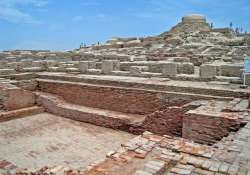Baghpat (Uttar Pradesh): When brick kiln workers stumbled upon human skeletal remains at Chandayan village, some 100 km from Delhi, no one had any inkling that it could be the first ever habitation from the later phase of Harappan civilisation to be found in the state.
The early Harappan phase lasted from 3300 BC to 2600 BC, the mature phase from 2600 BC to 1900 BC and the late phase from 1900 BC to 1600 BC.
“The artefacts came to light when labourers were digging farmland to collect clay for making bricks,” Superintending Archaeologist of Archaeological Survey of India A K Pandey told PTI.
“This is for the first time that a habitation of late Harappan era has been found in UP...though a burial ground was found in Sinauli in the past,” he said.
“It was a chance discovery when some labourers found a skeleton with copper crown on his head while digging mud for bricks,” Pandey said.
The crown is a thin strip of copper with two leaves of the metal and a Carnelian bead - a semi-precious stone typical of the remains found at other Harappan sites.
“The crown indicates that the skeleton was probably that of a local chieftain or village head. We have discovered terracotta pottery too.
But these are crudely crafted and not of very fine quality,” Pandey said.
The ASI then began extensive exploration of the site in the second half of last year in Baraut tehsil of Baghpat district on the plains of river Hindon, he said.
“During the excavation, we found certain items besides the human bones after which ASI Director General Rakesh Tewari granted permission for salvage operation of the site,” Pandey said.
He said that during excavation carried out in December, the fact came to light that there was a human habitation in the area some 4,000 years ago.
“In one of the excavation sites, a floor with mud wall was found. Whereas, at another place, four successive levels of the floor of a house were seen,” he said.
“A house has been discovered for the first time of late Harappan period in the upper Ganga-Yamuna Doab. It is one of the eastern most limits of the late Harappan civilisation,” he said.
Pandey said that besides the habitation, a burial area was exposed.
“It was found containing 21 burial pots each one different from the other in shape and size, perhaps they were filled with food material. Remaining parts of the skeleton were also found,” he said.
Pandey said beads of different types were also found from the site.
“Actually it was a ritual ceremony to place pots during late Harappan period,” he said.
Pandey said remains of cattle were also found near the burial ground.
“Some of the bones were found burnt indicating that animal sacrifice was offered during the funeral ceremony,” he said.
“From the pottery, is believed that the site belongs to late Harappan period. The pots are very similar to those found from Sinauli, which is 20 km from Chandayan site,” he said.
In Sunauli, the ASI had found 116 graves but could not carry out further digging for evidence of any habitation as the entire area was under sugarcane cultivation and the landowners did not allow more excavations.
“This is the second instance that a crown has been discovered. “This the second crown, the first one was found in Haryana,” he said.
“The finding is significant because the only other late Harappan site where we found such a crown was in Fatehabad district of Haryana. There, it was made of gold,” Tewari said.
Pandey explained that people at that time had connection with other late Harappan people as far as Punjab.
Latest India News
